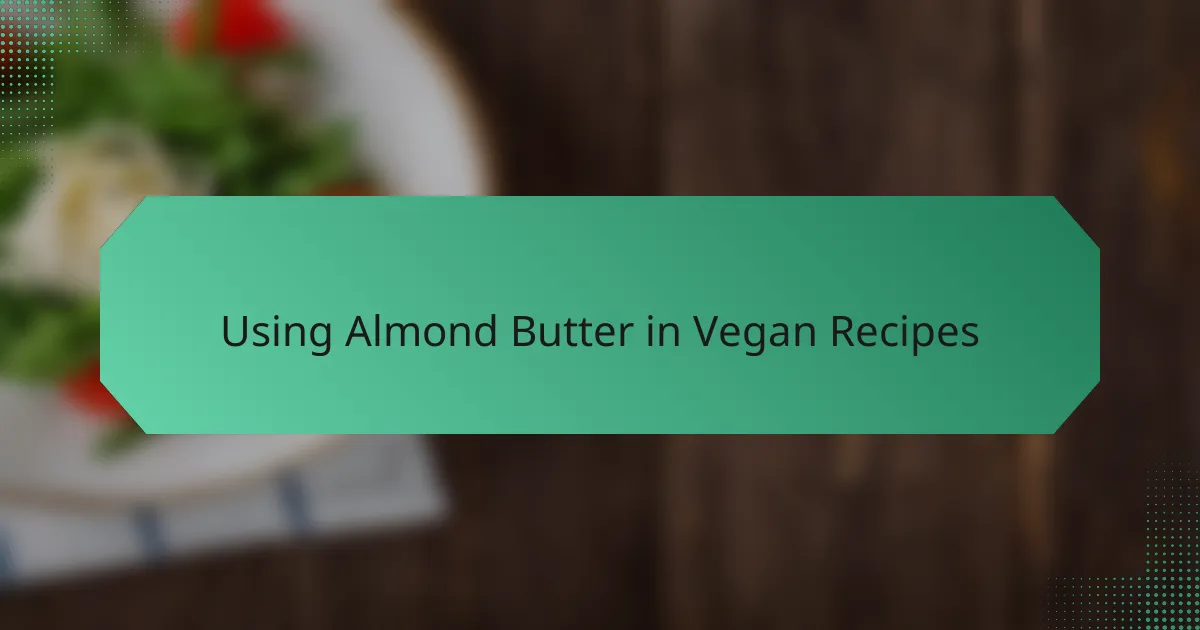Key takeaways
- Almond butter is a creamy spread made from pure almonds, offering a rich, nutty flavor and healthy fats without added sugars or preservatives.
- Making homemade almond butter provides control over ingredients, a rewarding experience, and the ability to customize flavors with simplicity.
- Key steps include roasting almonds for enhanced flavor and using a food processor to achieve the desired creamy texture, emphasizing patience throughout the process.
- Almond butter is versatile in vegan recipes, enhancing dishes like smoothies, oats, and salad dressings with its natural richness and nutrition.

What is Almond Butter
Almond butter is simply ground almonds transformed into a creamy spread. When I first tasted it, I was amazed at how the natural, nutty flavor packed such a satisfying punch compared to typical peanut butter.
Have you ever wondered why almond butter feels so rich and slightly sweet? It’s all thanks to the almonds’ healthy fats and natural oils that give it that smooth texture and deep taste, making every spoonful feel like a little indulgence.
To me, almond butter isn’t just a food; it’s a perfect example of how simple ingredients can be elevated with just a bit of love and patience. This humble spread has become a staple in my kitchen, offering both comfort and nutrition in one jar.

Benefits of Homemade Almond Butter
One of the biggest benefits I’ve noticed with homemade almond butter is the control I have over its ingredients. Unlike store-bought versions, I don’t have to worry about added sugars or preservatives sneaking in. It feels good knowing exactly what’s going into my body — pure almonds and nothing else.
Have you ever experienced that satisfying feeling when food not only tastes great but also fuels your body well? For me, almond butter delivers healthy fats and protein that keep me energized through a busy day. It’s a small change that made a big difference in how I fuel my vegan lifestyle.
Making almond butter at home also brings a sense of accomplishment. When I whip up a fresh batch, the creamy texture and rich aroma fill my kitchen with warmth. It’s a reminder that nourishing yourself doesn’t have to be complicated — sometimes, simplicity is the ultimate benefit.

Ingredients for Almond Butter
When it comes to ingredients for almond butter, I always keep it simple: just raw almonds. That’s it. No extra additives, no hidden sugars—just pure almonds roasted or raw, depending on the flavor I’m craving.
Sometimes I add a pinch of sea salt to enhance the natural nuttiness, but honestly, the almonds themselves provide so much flavor that extras feel unnecessary. Have you ever noticed how a tiny sprinkle of salt can transform a simple dish into something memorable? It’s the little touches like that which make homemade almond butter feel truly special.
Occasionally, I experiment by mixing in a teaspoon of maple syrup or a dash of cinnamon when I want a sweet twist. But most days, sticking to the original ingredient list reminds me why less is more—pure almonds, ground down to that luscious, creamy perfection I crave.

Step by Step Almond Butter Recipe
The first step in making almond butter is roasting the almonds to unlock their natural oils and deepen their flavor. I usually roast them at 350°F for about 10-15 minutes, keeping a close eye so they don’t burn—there’s nothing like that warm, toasty smell filling the kitchen to build anticipation. Have you ever noticed how roasting transforms raw nuts into something that smells like a cozy hug? That’s exactly what happens here.
Once roasted and cooled, the almonds go into my food processor. Here’s where patience kicks in: at first, the almonds turn into a crumbly meal, then slowly release their oils and start forming clumps. I find myself pausing every minute or so, scraping down the sides to keep everything moving smoothly. It’s almost meditative, watching the texture change from dry bits to creamy bliss.
If you’re wondering when to stop, I usually blend until the butter reaches a silky consistency that spreads easily but still has a little texture to remind me I’m eating real almonds. Sometimes I add a pinch of salt or a splash of neutral oil to help it along, but mostly, I let the almonds shine on their own. The moment I taste that fresh, homemade almond butter is always rewarding—it feels like a small victory that’s totally worth the wait.

Tips for Perfect Almond Butter
Getting the texture just right can be a bit of an art. I’ve found that patience is key—stopping to scrape the sides of the food processor every minute or so makes all the difference. Without this little habit, the almonds tend to stick and won’t break down evenly, leaving you with a grainy butter instead of that smooth, creamy dream.
Have you ever wondered how a tiny pinch of salt can elevate a dish? I swear it works wonders in almond butter too. A small sprinkle not only enhances the natural nuttiness but also balances the slight bitterness you sometimes get from roasted almonds, creating a depth of flavor that feels homemade in the best way.
If the butter feels too thick, adding just a splash of neutral oil like sunflower or grapeseed has saved me more than once. It’s a simple tweak that softens the spread without overpowering its pure almond taste. That little extra step made my batches spreadable, creamy, and perfect every single time—trust me, it’s worth experimenting with.

My Homemade Almond Butter Experience
Making my own almond butter was a surprisingly rewarding adventure. At first, I didn’t think it would be much different from the store-bought kind, but the moment I tasted that fresh, creamy spread, I knew I’d stumbled upon something special. Have you ever had a food that just feels warmer and more satisfying because you made it yourself? That’s exactly how homemade almond butter tastes to me.
I remember one afternoon spent turning roasted almonds into butter, watching the mixture transform from dry crumbs to a silky, spreadable delight. There’s something almost meditative about scraping down the sides of the food processor repeatedly, knowing patience is the secret ingredient here. Each batch feels like a small personal victory, especially when the rich aroma fills my kitchen and I know there’s nothing artificial inside.
Sometimes, I catch myself savoring a spoonful straight from the jar, appreciating how simple ingredients can create such comfort. Have you ever thought about how food made with care can nourish not just your body but your spirit too? For me, homemade almond butter isn’t just a recipe—it’s a little ritual that brightens my day.

Using Almond Butter in Vegan Recipes
Using almond butter in vegan recipes has been a game changer for me. Have you ever tried swapping out traditional oils or spreads with almond butter? It adds a creamy richness that feels both indulgent and wholesome, elevating simple dishes like smoothies or toast with its natural nuttiness.
I often stir a spoonful into my overnight oats or blend it into sauces for extra depth and protein. The versatility surprises me every time—whether I’m making a salad dressing or vegan desserts, almond butter brings a subtle sweetness and texture that store-bought spreads just can’t match.
What excites me most is how almond butter helps me keep my recipes clean and simple. Instead of reaching for processed ingredients, I rely on this homemade staple to add flavor and nutrition effortlessly. It’s like having a secret ingredient that never fails to make a dish feel thoughtfully crafted.